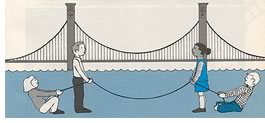
Ron Bogle Takes AAF Helm
Ron Bogle, who was appointed this summer as president of the American Architectural Foundation, sat down with AIArchitect Associate Editor Tracy F. Ostroff to share his thoughts about the state of the AAF and his plans for cultivating and furthering the organization's mission. In his new role, Bogle says he hopes to help facilitate constructive civic engagement to benefit architectural activities, generate financial support for scholarships and educational programs, and visit several cities to raise awareness about the AAF and its agenda. He says he plans to work hard, maintain his sense of humor, and "make good things happen."
 Bogle,
50, has spent the past decade in higher education and many years "involved
in and around the architectural field." Before becoming vice president
of external affairs at the University of Central Oklahoma in Edmond, he
was vice president for marketing and business management at HTB in Oklahoma
City and worked at the Gould Evans Partnership in Kansas City, Mo. Bogle
served on the Oklahoma City School Board for nine years.
Bogle,
50, has spent the past decade in higher education and many years "involved
in and around the architectural field." Before becoming vice president
of external affairs at the University of Central Oklahoma in Edmond, he
was vice president for marketing and business management at HTB in Oklahoma
City and worked at the Gould Evans Partnership in Kansas City, Mo. Bogle
served on the Oklahoma City School Board for nine years.
A devotee of music and the arts, Bogle sings and plays the piano. He says he will be a part of a "two-community family" for a while. His wife, a psychologist and university faculty member is in Oklahoma City with their daughter, a junior, who will graduate from her hometown high school. His son is a sophomore at Trinity University in San Antonio.
![]() What
is the state of the Foundation?
What
is the state of the Foundation?
The staff has been reduced considerably over the last year or so, and there's a need to reengage a number of sponsors, donors, and supporters who will help fund our programs. On the plus side, I find that the Board of Regents is very, very committed and enthusiastic about supporting the Foundation. We have an outstanding chair in Harold Adams. The staff members who are still here are as committed a group as you would ever want to work with—enthusiastic and supportive. I find every engagement with the AIA is very positive and very supportive, and the AIA is, I think, actively seeking to find ways to help the Foundation. So I find a fertile environment for really rebuilding and growing the Foundation to be a vital force in the field of architecture in the nation.
Part of what we're trying to do is get our books organized in such a way that we have a better idea of where we are financially. The operating budget of the Foundation is less than it was because there hasn't been quite as an aggressive effort for fundraising—but there appears to be plenty of support out there.
Of course, our principal asset is The Octagon [the museum of the AAF] itself. But the Foundation also holds about $7 million in endowment that is restricted for supporting various programs of the organization.
The Regents are very serious about putting the Foundation on a constructive track and rebuilding some of the programs that have been present in the past but, for various reasons, have been either reduced or removed from the program of work. I'm excited to be here, to be a part of what will be the rebuilding and the strengthening of the Foundation, and also cementing the relationship between the Foundation and the AIA. It's an important partnership. [AIA Executive Vice President/CEO] Norman Koonce is an excellent leader of the AIA, but he's also probably the Foundation's biggest fan, so I'm looking forward to our partnership, working together to achieve our goals.
![]() Do
you have any specific plan about how you might go about achieving these
goals?
Do
you have any specific plan about how you might go about achieving these
goals?
I'm going to do a lot of listening and because of my background in nonprofit management and fundraising and marketing, I hope I can tap some of my own experiences to raise the profile and impact of the Foundation. We want to position the Foundation as a significant national voice conveying the message of the power of architecture in shaping our lives and forming our communities.
We must not be seen as "just" a Washington institution, even though we're based here. We're going to take our show on the road—so to speak—this next year to really begin to establish ourselves as a national voice. We're going to be visiting cities around the country to get to know our constituents outside of Washington better. There will be a lot of friend-making and fund-raising, and we plan to bring more services to local communities. It's a beginning toward developing a different kind of national network than may have existed before now.
![]() What
interested you in this job?
What
interested you in this job?
I was vice president for marketing and business management for a major architecture firm. So, for a period of time I was in and around the AIA world and really developed a strong appreciation for both the field of architecture and the influence that architecture has in our lives. Through my involvement on the school board, I saw firsthand how structures can play a role, either constructive or negative, in the lives of young people, teachers, and neighborhoods. I've come to appreciate the need for people to understand that architecture is not just shelter, not just protection from the elements, but an integral part of shaping us as persons.
![]() Who
do you see as your biggest constituencies?
Who
do you see as your biggest constituencies?
 There
are many. One constituency could be school children, because one of our
school programs, Learning by Design,
is really focused on helping school children understand, in the way that
they're able to, the importance of architecture as a legacy of culture,
as it impacts our lives. Another constituency is the nation's mayors,
through the Mayors' Institute on City Design, which is a program we administer
for the National Endowment for the Arts and the U.S. Conference of Mayors.
It's an important constituency because mayors by and large have a tremendous
impact on architectural issues in their communities.
There
are many. One constituency could be school children, because one of our
school programs, Learning by Design,
is really focused on helping school children understand, in the way that
they're able to, the importance of architecture as a legacy of culture,
as it impacts our lives. Another constituency is the nation's mayors,
through the Mayors' Institute on City Design, which is a program we administer
for the National Endowment for the Arts and the U.S. Conference of Mayors.
It's an important constituency because mayors by and large have a tremendous
impact on architectural issues in their communities.
 Here
in Washington, we have a whole group of constituents that are interested
in The Octagon Museum, its rotating exhibitions, and its value as an historic
house in Washington and an example of period architecture. We have scholarship
recipients each year who receive funding through our women and minority
scholarship programs.
Here
in Washington, we have a whole group of constituents that are interested
in The Octagon Museum, its rotating exhibitions, and its value as an historic
house in Washington and an example of period architecture. We have scholarship
recipients each year who receive funding through our women and minority
scholarship programs.
![]() Are
there other programs that you would like to initiate?
Are
there other programs that you would like to initiate?
There's a higher level of service that the Octagon can provide, and we need to discover what that is and work toward that goal. When Norman Koonce was the president of the Foundation, he and others led a very successful campaign to restore the Octagon, so it's in wonderful physical condition thanks to the leadership of that group. Now we have to decide what we want the Octagon to be.
I think we need to restore to previous strength the programs of the Foundation. The Learning by Design program is a little bit dormant right now, and we need to reinvigorate it and establish funding for it. That can be such an important outreach to communities. It is our intention to seek additional funding for the scholarship programs and the grant programs as well.
We must decide what role the Foundation play in responding to the current needs in our society as related to the built environment. Through a process of listening and asking these questions of others—"What should we be? What should we do?"—I think that powerful answers will evolve and we can transform the Foundation into a significant voice nationally to educate people about the value of architecture.
In the coming years, we will work hard, have a lot
of fun, and make some wonderful things happen.
Copyright 2002 The American Institute of Architects. All rights reserved.
![]()